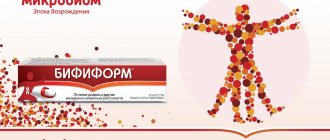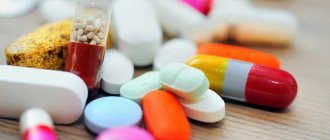Considering the important function that living bacteria perform in our body, ignoring the balance of microflora in the intestines during treatment with antibiotics can lead to various adverse consequences - ranging from banal diarrhea to serious immunological disorders. Probiotics during antibiotics, as well as after etiotropic antibiotic therapy, are an effective method for the prevention and treatment of dysbiosis (dysbacteriosis) - this is the opinion of leading experts in various fields of medicine around the world. This is also confirmed by numerous clinical studies in the USA, Europe, Ukraine and many other regions. offers the best probiotics when taking antibiotics - Apibact® and Symbiter®. Below we will look at:
- How do antibiotics affect the intestinal microflora?
- Can I take probiotics while being treated with antibiotics?
- How long to take live bacteria after antibiotics?
- Why are Apibact® and Symbiter® the best probiotics for antibiotics?
- How to choose a children's probiotic when taking antibiotics?
Antibiotics and probiotics
Antibiotics are one of the most important groups of drugs that are used in almost any medical field. The presence of antibiotics in the arsenal of a modern doctor makes it possible to fight the most dangerous infectious diseases and their complications. But do not forget that taking antibiotics, especially long-term, never goes away without leaving a trace.
Most antimicrobial drugs inhibit the vital activity of bacteria, as well as their ability to reproduce, including those found in our intestines - beneficial microorganisms that provide important digestive processes and immune responses. That is why we recommend using probiotics with antibiotics starting from the first day of etiotropic therapy.
Should I use probiotics when taking antibiotics?
Should I take probiotics with antibiotics? We offer you 5 reasons why this is a rational decision!
- The risk of developing dysbiosis (dysbacteriosis) when taking antibiotics increases tenfold. Dysbiosis causes problems such as: abdominal pain, increased gas formation, diarrhea, loss of important fats and electrolytes, weight loss, impaired absorption of vitamins in the intestines, neurological disorders, decreased tolerance to allergens and much more;
- Probiotics combined with antibiotics reduce the chance of microflora imbalance to almost zero. Multicomponent multiprobiotics with an adapted composition and symbiotic strains “Symbiter®” and “Apibakt®” contain billions of beneficial bacteria that support important intestinal functions even in conditions of severe infectious disease and antibiotic therapy;
- Multiprobiotics inhibit pathogenic flora - specially bred strains of bacteria at the Institute of Microbiology and Virology of the National Academy of Sciences of Ukraine actively suppress the vital activity and reproduction of pathogenic flora in the intestines, that is, they enhance the effect of antibiotics;
- Live bacteria in probiotics participate in the synthesis of beneficial substances - namely: B vitamins, vitamin K, folic acid. These substances play an important role in blood clotting, the functioning of the nervous system, hemoglobin synthesis and many other processes;
- Probiotics destroy toxic metabolites - harmful substances formed in the cells of pathogenic microbes, as well as in the liver and kidneys during the course of an infectious disease and taking antibiotics. Metabolites are actively suppressed by live bacteria, which are part of multiprobiotics.
Based on the results of clinical studies in which the drugs “Symbiter®” and “Apibact®” participated, this is only a small part of the beneficial effects that multiprobiotics can bring to the body when taking antibiotics.
Which probiotic is better when taking antibiotics?
Which probiotics are best to take with antibiotics? Let's outline several criteria that determine the rationality, effectiveness and safety of a probiotic during antibiotic therapy.
- The drinking form is a priority - liquid forms of probiotics contain live bacteria that begin to interact with the body immediately after consumption. In turn, probiotics with lipophilically dried bacteria begin to work 6-8 hours after consumption. Most of the bacteria die in the stomach, others do not have time to fulfill their function and are excreted from the body;
- Number of strains – monostrain probiotics are ineffective; they are often created to solve a specific problem. At the same time, multiprobiotics, such as “Symbiter®” and “Apibakt®” contain up to 24 strains of beneficial bacteria that are in close symbiosis, support the functional activity of the intestines, participate in digestive processes, and complement each other’s beneficial properties;
- Local strains - the concept of local strains of bacterial flora has been known not so long ago. To date, it has been proven that the use of live bacteria isolated from the bodies of people living in the same region is significantly more effective than those developed in other regions;
- Only studied strains of bacteria - choose probiotics that contain proven strains of beneficial bacteria. Today there are many of them, for example, Lactobacillus plantarum, Lactobacillus brevis, Lactobacillus acidophilus, Bifidobacterium lactis, Bifidobacterium bifidum, Bacillus Subtilis and others. It is better to avoid drugs that have not undergone full clinical trials;
- Brand – although the effectiveness and safety of a drug does not always depend on the popularity of the manufacturer, it is worth sticking to a trusted brand. For example, it has been producing and selling multiprobiotics in Ukraine since 1993, which is why millions of patients trust us.
Bifidobacteria when taking antibiotics
Bifidobacteria are the most numerous group of gram-positive bacteria inhabiting the gastrointestinal tract. In children, bifidobacteria make up 80% to 90% of the total microflora.
The role of bifidobacteria is difficult to overestimate. Their effectiveness has been proven in:
- Creating a protective barrier for the intestinal mucosa;
- Processes of suppression of the vital activity of pathogenic flora;
- Disposal of food substrates;
- Synthesis of vitamins B1, B2, B3, B5, B6, B9, K, amino acids, proteins;
- Absorption processes of iron, vitamin D, Ca.
Bifidobacteria are very vulnerable when taking antibiotics; an imbalance of this flora causes serious metabolic disorders in the body, aggravates intoxication, and reduces the immune activity of cells.
Lactobacilli when taking antibiotics
Lactobacilli are a group of non-pathogenic microorganisms that are found in large numbers in the human gastrointestinal tract. Today, there are more than 130 strains of these bacteria, in particular lactobacilli and lactococci. Lactobacilli live primarily in the large intestine, performing a number of useful functions, namely:
- Inhibition of the growth of putrefactive microflora;
- Protection of the intestinal epithelium;
- Synthesis of enzymes, antimicrobial substances, immune cells;
- Reduced activity of pro-inflammatory mediators;
- Optimization of acid-base balance;
- Participation in the processes of food digestion.
When taking antibiotics, lactobacilli are actively suppressed, which requires immediate replenishment of beneficial microflora by taking a probiotic.
Colonization assessment
In 2015, Elinav and his colleague Eran Segal, a computational biologist, demonstrated that the same food can have different effects on blood sugar in different people without diabetes, depending in part on the microflora their intestines.
These scientists developed a method for predicting postprandial blood glucose peaks based on a wide range of clinical and laboratory parameters, including stool microbiota. Predicted changes in blood glucose were used to develop a personalized diet to help reduce postprandial blood glucose peaks. Subsequently, this approach was registered as an innovation in the field of nutrition.
Elinav and Segal, in their latest work, suggest that the most effective means of restoring gut microflora is one that is personalized. In their new study, they, along with Zamir Halpern, chief of internal medicine at the Institute of Gastroenterology at Sourasky Medical Center in Tel Aviv, Israel, revisited key issues that they feel they did not adequately address in their previous studies. works: to what extent do probiotics colonize the human intestine and what effect do they have on it?
In the first study, nineteen healthy volunteers took either a commercially available 11-strain probiotic supplement or a placebo twice daily for 4 weeks. According to Elinav, the supplement included the 4 main genera of bacteria used in probiotics around the world.
Rather than relying solely on stool studies (which is common practice in gut microbiota studies), the researchers also examined sites throughout the gastrointestinal tract, both before and during a course of probiotics. Using colonoscopy and deep endoscopy of the upper digestive tract, the scientists collected samples of the contents and lining of the intestine, and also performed a biopsy of its tissue. The samples were then subjected to extensive genetic sequencing to determine microbiota composition, function, and gene expression of host intestinal cells.
Gut lining samples taken 3 weeks after starting a course of probiotics showed that subjects taking antibiotics could be divided into 2 camps: “susceptible” and “resistant”. Susceptible volunteers demonstrated significant levels of probiotic strains in the intestinal lining, whereas no significant colonization was detected in the intestines of resistant volunteers. Susceptible individuals also showed changes in the indigenous microbiome and gene expression profile throughout the intestine, which was not observed in resistant subjects or in the placebo group.
According to Colleen Kelly, a gastroenterologist and professor at Warren Alpert Medical School at Brown University who was not involved in the study, the work is the first to demonstrate that in some people the intestinal lining is resistant to probiotic colonization , “where all the action happens.” "
The baseline natural gut microbiome of volunteers largely determines whether they will be susceptible or resistant to probiotics. Interestingly, no such difference was found in stool samples: both susceptible and resistant subjects showed comparable amounts of probiotic bacteria, with more bacteria found in the stool of placebo-treated volunteers.
According to Elinav, these results suggest that " our current approach to probiotics is probably wrong ." This variability between individuals means that some people may benefit from taking probiotics and others may not.
This result is not surprising, said Rob K., Ph.D., director of the Innovative Microbiome at the University of California, San Diego, who was not involved in the study. He noted that different people react differently to the same foods, drugs and pathogens “This extends to beneficial organisms,” he said of the study, adding that previous work had found similar variability.
There is a general consensus among doctors and the public that ingesting “good” bacteria can crowd out “bad” bacteria and improve gut health even in a healthy person. Most clinical studies published so far on healthy volunteers have not found significant changes in gut microflora. With the publication of the Weizmann Institute of Science study, the health claims of probiotics are more controversial than ever. Kelly says, " The idea that people take probiotics just to improve their overall health may be a waste of money ."
Probiotics for children taking antibiotics - recommendations
The microbiota in children is formed over a rather long period. A child is born with a sterile intestine. Contamination of the skin, mucous membranes and intestines occurs primarily from the mother and father. In the first years of life, the absolute majority of microorganisms are bifidobacteria, with lactobacilli in second place.
Due to the imperfection of the immune and digestive systems, microflora imbalance regularly occurs in the child’s intestines, which can manifest itself as diarrhea, constipation, bloating and abdominal pain. The final formation of the microbiome occurs only by 12-13 years.
Depending on age, the presence of acute and chronic diseases, and the state of the digestive system, the optimal multiprobiotic should be selected at different stages of the child’s life. offers effective and safe probiotics with antibiotics for children from the 1st day of life.
- "Symbiter®" acidophilus;
- "Simbiter®" M-children;
- "Simbiter®" forte-D and others.
You can get acquainted with the detailed instructions for multiprobiotics in the product profile on our website, at the points of sale of our partners in Kyiv and other regions of Ukraine. Need some advice? Contact a specialist by phone or in an office in Kyiv.
Why are live bacteria needed after antibiotics?
On average, the course of antibiotic therapy ranges from 5 to 10 days, depending on the type of infectious disease, the severity of the condition and the effectiveness of treatment. Why do we recommend using probiotics for at least 3-4 weeks?
The fact is that the beneficial intestinal flora is not restored so quickly; residual pathophysiological processes, as well as circulating toxic metabolites after an infection, can suppress the microflora for some time even after complete recovery. Risk groups are especially susceptible to the following conditions:
- Children under 3 years old;
- Pregnant and lactating women;
- Elderly people over 65 years of age;
- Persons with congenital and acquired immunodeficiency;
- Persons suffering from various diseases of the stomach, liver, pancreas, gallbladder, intestines;
- Persons suffering from diabetes.
Main types of probiotics used in pediatrics
In a review of the material tabulated in the WGO global guidelines with levels of evidence according to the Oxford Center for Medicine criteria, some very interesting data were published.
For ease of understanding, we will not go into details, but will only list the most effective probiotic strains. These include: LGG, Saccharomyces boulardii, Lactobacillus reuteri.
In practice, pediatricians often use intestinal probiotics such as (list of the best drugs):
- Buck-Set;
- BioGaya;
- Normobact L;
- Prema Kids;
- Yogulact;
- Lactobacterin;
- Bifidumbacterin;
- Enterol;
- Lactofiltrum;
- Lactulose and others.
They are quite common drugs. Therefore, it will not be an exception that the pediatrician will make an entry in your child’s outpatient card with the prescription of one of the above medications.
Probiotics and prebiotics are essential drugs for many gastroenterological diseases in children. They allow you to normalize the child’s intestinal microbiota, which plays a significant role in many processes. These drugs must be prescribed according to indications with a specific dosage and duration of use. You need to take probiotics responsibly. Do not self-medicate; if your baby develops symptoms of the disease, contact your pediatrician, who will select the best probiotics for your baby and tell you how to take this drug.
The best probiotics when taking antibiotics are Apibact® and Symbiter®
“Simbiter®” and “Apibact®” are the best probiotic preparations in Ukraine, which have proven their effectiveness not only in the practice of clinical specialists, but also according to the results of numerous studies conducted by us together with leading scientific institutes of Ukraine and other countries.
Advantages of multiprobiotics “Simbiter®” and “Apibact®”:
- Liquid form – begins to work immediately after application;
- Contains from 13 to 24 strains of non-pathogenic bacteria;
- Live bacteria in multiprobiotics are obtained from local strains and are easily absorbed by the body;
- Contains symbiotic strains that potentiate each other's positive effects;
- Do not reduce the effectiveness of antibiotic therapy;
- Do not cause antibiotic resistance at the genetic level;
- Suitable for children from 1 day of life and adults.
Is there a “magic pill”?
Probiotic preparations appeared somewhere in the middle of the last century. Then they spread. The drugs demonstrated their remarkable properties in numerous experiments.
This group of drugs had practically no contraindications, and many thought that a magic elixir had been found. I took a pill and forgot about my health problems. But these were only forecasts. In practice, many patients simply wasted their money, and the results were not always pleasing to the patients. Currently, more and more reports have begun to come not about the benefits of the drug, but about its harm to health.
Where to buy multiprobiotics for adults and children in Ukraine?
Probiotics when taking antibiotics, as well as during the process of restoring the body after antibiotic therapy, greatly reduce the chances of developing intestinal dysbiosis and impaired immune function of the body.
offers the best probiotic for antibiotics - “Symbiter®”, as well as “Apibakt®”, which effectively eliminate the symptoms of diarrhea, prevent the development of electrolyte disturbances, enzyme deficiency, immune suppression, and most importantly - our drugs are suitable for all categories of patients - adults, children, pregnant and lactating women, persons with lactose intolerance.
You can buy multiprobiotics “Simbiter®” and “Apibact®” online on our website, or at drug sales points in Kyiv, Kyiv region and other regions of Ukraine.









